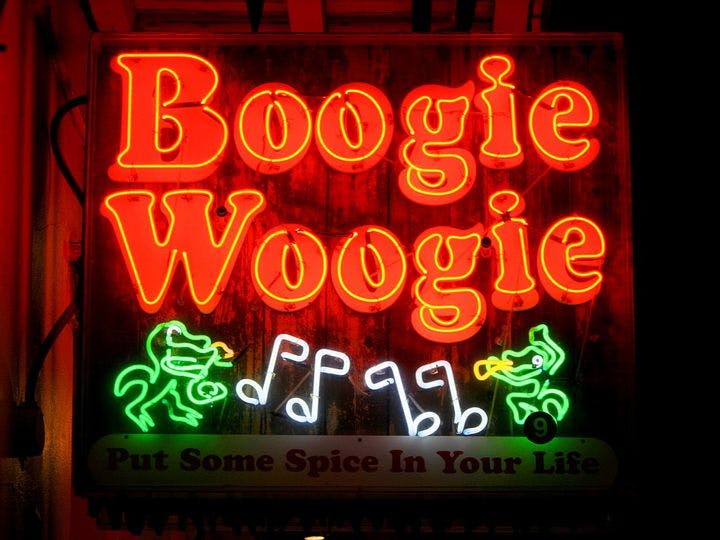Winter 2010
Boogie On!
– The Wilson Quarterly
"Boogie" isn't just a kind of dance anymore — it's a feeling.
The boogie is everywhere. We say “Let’s boogie” to mean “Let’s get going.” Madonna sings its praises. Country’s Johnny Cash, rock ‘n’ roll’s Chuck Berry, the blues’ John Lee Hooker, and countless others rode its distinctive propulsive rhythm. Though the word once referred to a very particular musical style, diffusion throughout American culture means that it has come to represent much more than a kind of music. It’s all about a certain feeling—and that feeling’s a good one, says Burgin Mathews, a writer living in Birmingham, Alabama.
The boogie emerged at the turn of the 20th century and for a time went by a variety of names—barrelhouse, walking the basses, the sixteen, the fives, western rolling blues, and many others. The term didn't appear in print until 1928, when a recording by pianist Clarence “Pine Top” Smith was released with the title “Pine Top’s Boogie Woogie.” The music may have had many names, but its original sound was distinct—piano music featuring right-hand improvisations over a heavy left-hand bass pattern, known as a “rolling bass.” Often the style is explained as an attempt to translate the sounds of a guitar or banjo to a piano, but Mathews suspects it sprang from another source: the sound of a train. One student of the genre wrote that it represented “the haunting sound of whistles, expresses romping along on a full head of steam, wheels clattering over points and, of course, the insistent rhythm of the driving wheels.”
Boogie spread from the rural South westward into Texas, Arkansas, and Oklahoma, and north to the Midwest by way of the turpentine and lumber camps where many African Americans labored in the early 20th century. On weekend nights, the hearts of these camps were their rowdy social halls, called barrelhouses, where traveling musicians would play the boogie and people would dance and drink the night away. In the 1930s, as many African Americans migrated to the urban centers of Birmingham, New Orleans, New York, Kansas City, St. Louis, Pittsburgh, and, above all, Chicago, they brought the boogie with them.
By the end of the 1930s the sound had crossed over into white American culture, a transition perhaps best captured by an acclaimed performance of a Chicago-based boogie piano trio at the “Spirituals to Swing” concert in 1938 at Carnegie Hall, the temple of white American music.
In the decades that followed, the boogie lost ground as a distinctive genre, but its influence only grew as the sound was diluted. It laid the groundwork for rock ‘n’ roll. Disco dancers, gangsta rappers, and country musicians all owe it their due. “Boogie [became] broad and flexible enough to encompass any type of music, provided that music contained some element of high energy and upbeat dance,” Mathews says. The barrelhouse dance halls and rumbling bass lines may be things of the past, “but the boogie-as-idea persist[s].”
* * *
The Source: "'When I Say Get It': A Brief History of the Boogie" by Burgin Mathews, in Southern Cultures, Fall 2009.
Photo courtesy of Flickr/Chuck Coker
